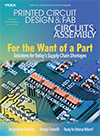The East Coast trade show brings news of a steady industry, while puncturing myths about AI.
Members of the electronics community gathered in the Boston suburb of Boxborough in early June for the return of PCB East, PCEA's annual event featuring four days of technical sessions and a one-day exhibition.
This year's exhibition featured more than 65 companies running the gamut of the PCB industry, from fabrication, design, and assembly to test and inspection, and most of those companies reported steady growth thus far, with small gains over 2023.
Moving forward on the ‘More than Moore’ roadmap.
We’re witnessing a rapid evolution in advanced semiconductor nodes and market growth due to the meteoric rise of AI, mobile, autonomous automotive, IoT, communications and cloud, health tech, and wearables. The various technologies driving the overall functionality of systems and devices associated with these applications have increased exponentially, impacting factors such as device performance, energy consumption, power dissipation, and space (miniaturization).
Navigating the balancing act with the application constraints.
Understanding and controlling the assembly process window is not just about managing the solder paste. It’s about mastering all process variables across the entire SMT assembly process for optimal outcomes.
The assembly process window defines the range of parameters within which solder paste will meet optimal performance standards. Straying outside this window can lead to defects, rework and inconsistencies, affecting the efficiency and output of the electronics manufacturing process.
The choice of flux plays a significant role.
Although the rework bench plays a critical role in electronics manufacturing, engineers often overlook its cleanliness due to its lack of flashy machinery and perceived simplicity. Skilled hand solder operators proficiently completing their tasks can lull supervisors into a false sense of security, particularly since electrochemical contamination issues don’t manifest in this environment.
But in fact, as many as eight out of 10 contamination-related issues can be traced back to the rework bench. Here, we look at how these contaminations occur as well as how to prevent them by examining common products and tools in the rework bench environment.
Buoyed by the US-China trade war, Mexico and Malaysia are making their move.
On Jan. 6, 2023, the Wuxi Welnew Microelectronics plating plant in Wuxi, China, was decimated by a fire.
You’ve probably never heard of Welnew. It is a supplier of electroplating (Sn, SnBi, SnCu, L/F Ag, ZnNi, and so on) to a host of semiconductor manufacturers including Infineon, Vishay, Bosch, Osram, Onsemi, Renesas, Toshiba and others. Welnew is critical to the supply chain: It claims a 60% market share for plating parts ranging from Mosfets, RF devices and LED drivers.
This happens in supply chains. If it’s not a typhoon, it’s a volcano. If it’s not a flood, it’s a fire. If it’s not an epidemic, it’s a pandemic. Lines and factories go down. Disruptions occur. Prices and lead times fluctuate, sometimes madly.
A thermal processing expert’s take on which tests are ideal for comparisons.
I get asked how I would evaluate the performance of a reflow oven because of my experience with oven testing and participation in the IPC Reflow Oven Process Subcommittee. Some of the questions are basic, such as “Which oven should I purchase?” “Is this new oven as good as the older one?” or “Will it work with my boards or specific process requirements?” Other questions are more complicated: “Will this oven help me produce an acceptable profile with our heavy board?” or “Is this oven better than XYZ’s reflow oven?”
Press Releases
- Altus Reports Growing Demand for Guidance on Convection Reflow Oven Specification
- Coherix Opens New Adhesive-Dispensing Vision Center in Europe
- Pan Pacific Strategic Electronics Symposium Program Finalized
- The Most Critical 2 Inches in SMT Manufacturing – When a Splice Fails, the Line Fails, Full Stop. Throughput and Yield Depend on One Overlooked Moment


